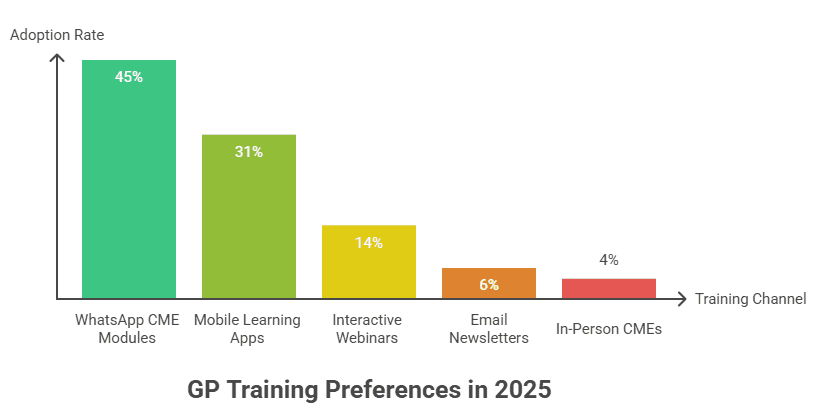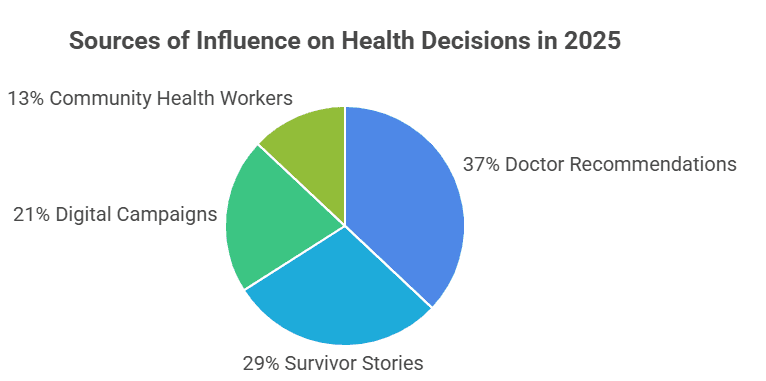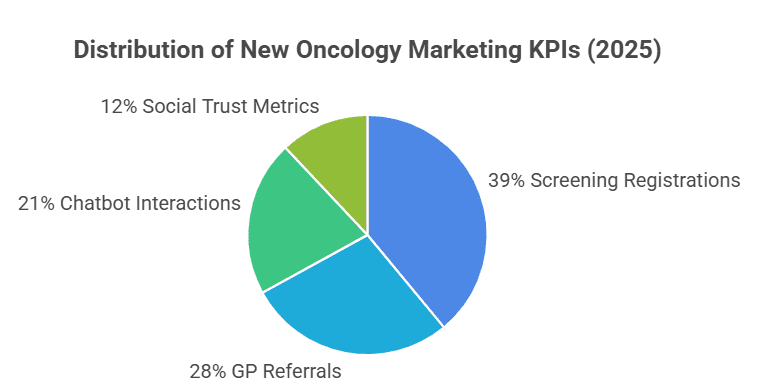Introduction: Marketing With Meaning in Modern Oncology
Oncology is a field where time, trust, and truth can change lives. In 2025, pharma marketing is no longer about broadcasting product details; it’s about bridging science with patient stories. With AI diagnostics, genomic medicine, and immunotherapy breakthroughs redefining cancer care, oncologists need campaigns that educate, empower, and enable better decisions.
This new era requires pharma to go beyond promotion—to become a partner in patient journeys. Campaigns must focus on awareness, accessibility, and authenticity, ensuring that marketing is not just persuasive but transformative.
This evolution highlights how oncology marketing now serves as a critical link between science and society. By aligning communication with patient realities, pharma ensures campaigns translate into real health action.
1. Patient-First Marketing Frameworks
Oncology patients demand more than information; they seek reassurance. Pharma campaigns now feature multilingual guides, survivor stories, and easy-to-use tools, positioning brands as partners in healing.
Patients who feel supported are more likely to engage with recommended screenings and treatments. A patient-first approach ensures that marketing fosters confidence instead of confusion.
This model transforms campaigns into lifelines of hope and clarity, reinforcing trust in pharma beyond medication.
2. Smarter Data-Driven Segmentation
Cancer care differs across regions, and campaigns must reflect this diversity. AI-driven data segmentation allows pharma to target campaigns by cancer prevalence, demographics, and digital behaviors.
This precision ensures outreach resonates with real-world challenges, from breast cancer awareness in cities to oral cancer prevention in rural communities.
Segmentation also reduces wasted resources, ensuring every communication is timely, relevant, and impactful.
3. GPs as Early Detection Catalysts
General practitioners remain the first checkpoint for potential cancer symptoms. Pharma supports them with quick diagnostic kits, CME modules, and referral networks, accelerating early detection.

These resources strengthen GP confidence, ensuring fewer missed referrals and earlier oncology intervention.
Empowering GPs with tools ensures that life-saving referrals become routine practice, not exceptions.
4. Omnichannel Outreach for Oncologists
Pharma no longer depends on one channel. Instead, integrated omnichannel strategies deliver consistent messaging across apps, webinars, emails, and in-clinic tools.
This ensures oncologists access information in their preferred formats, boosting retention and professional trust.
Omnichannel models also create seamless continuity, making learning and engagement effortless for busy clinicians.
5. Behavioral Nudges for Screening Uptake
Behavioral science drives campaign success. Nudges such as birthday reminders for checkups, gamified quizzes, and small incentives boost participation in screenings.
These subtle cues encourage patients to act on awareness instead of delaying, creating measurable improvements in early detection.
Nudges also reduce decision fatigue, helping patients make healthy choices feel simple and natural.
6. Survivor Storytelling: Empathy in Action
Nothing is more powerful than a survivor’s voice. Pharma campaigns that spotlight survivor journeys achieve greater trust, higher engagement, and emotional connection with audiences.
Stories transform abstract statistics into lived experiences, inspiring others to seek timely care.
Survivor narratives also build emotional credibility, showing communities that early action leads to recovery.
7. AI-Enabled Personalized Messaging
AI tools match patient behaviors with custom content. A smoker searching for “persistent cough” may get lung cancer resources, while a woman searching for “breast lump” receives a self-exam video.

This personalization ensures that campaigns feel relevant, timely, and trustworthy.
Personalized campaigns create higher engagement rates, helping patients feel seen and understood.
8. Vernacular and Cultural Campaigns
Pharma brands increasingly localize campaigns in regional languages, leveraging folk media, local radio, and cultural events.
Localized efforts resonate more deeply, especially in rural and semi-urban areas, where trust often depends on cultural relatability.
These culturally tuned campaigns reduce stigma and build stronger community participation in screening drives.
9. Digital Tools for Oncology Specialists
Pharma provides AI dashboards, clinical trial updates, and peer forums for oncologists. These tools save time and support evidence-based decisions, positioning pharma as a knowledge partner.
Oncologists see brands not as sellers but as collaborators in advancing cancer care.
These tools build loyalty by providing practical, daily value to clinical practice.
10. New Oncology KPIs for Impact
Clicks and impressions no longer suffice. Success is now measured by screenings booked, referrals made, and survivor communities engaged.

This shift ensures pharma marketing aligns with real-world health outcomes, not vanity metrics.
It redefines success as lives touched and lives saved, elevating the purpose of oncology marketing.
11. Micro-Influencers in Oncology Awareness
Community oncologists, nurses, and survivors serve as micro-influencers with grassroots trust. Their endorsement carries more authenticity than celebrity campaigns.
By empowering them with content, pharma creates locally resonant awareness movements.
Micro-influencers build long-term credibility because they are trusted members of the community. Their advocacy feels natural, not staged, which makes audiences more receptive. Involving them ensures that pharma campaigns are personalized, relatable, and trusted at the grassroots level.
12. Predictive Campaign Deployment
AI tools forecast cancer-related trends based on search patterns and patient data. Pharma uses these insights to launch campaigns before a surge in demand, staying proactive rather than reactive.
This predictive approach transforms marketing into an early-warning health intervention.
It also allows pharma to allocate budgets more effectively by targeting regions with the highest need. Predictive analytics ensures that campaigns are not just timely but also cost-efficient and impactful, maximizing return on investment.
13. Gamification to Motivate Patients
Pharma-backed apps integrate gamified tools such as risk scores, health badges, and screening challenges. Patients find prevention engaging and less intimidating.
Gamification makes preventive care accessible, interactive, and repeatable.
It also fosters friendly competition in families and communities, motivating collective participation. By making health fun, gamification reduces fear and builds positive associations, turning prevention into a rewarding lifestyle choice.
14. Wearables in Preventive Oncology
Smart wearables sync with pharma apps to track health and deliver cancer awareness prompts. Sudden changes in vitals can trigger reminders for screenings.
This real-time integration ensures prevention remains front-of-mind for at-risk patients.
Additionally, wearables facilitate smooth communication between doctors and patients. Data collected creates opportunities for personalized intervention. Over time, this transforms cancer awareness into a daily practice woven into everyday life.
15. Public-Private Collaboration Models
Pharma teams up with NGOs and governments to co-sponsor screening camps, health weeks, and rural outreach programs.
These collaborations build trust, scale, and shared accountability, amplifying campaign success.
Public-private partnerships also allow campaigns to leverage infrastructure and manpower from both sectors. This ensures broader penetration in rural and underserved areas. Such alliances make cancer awareness more sustainable and far-reaching.
16. Survivor Communities in the Digital Space
Pharma fosters online survivor communities that host webinars, peer mentoring, and support groups.
These communities offer both emotional strength and valuable insights into real-world patient experiences.
They also create safe spaces where patients and caregivers share fears openly. For pharma, these forums become listening posts for authentic feedback. This mutual exchange turns communities into trust hubs that benefit both patients and companies.
17. Voice-Based Awareness Tools
With IVR and voice bots, pharma delivers content in regional languages, reaching populations with low literacy.
Voice-first outreach ensures accessibility across socio-economic divides, making cancer education more inclusive.
Such initiatives provide quick and clear information in areas where written resources fail. They also overcome digital literacy barriers, ensuring cancer campaigns reach every corner of society without exclusion.
18. Sentiment Monitoring for Adaptive Campaigns
AI sentiment analysis detects public emotions around campaigns. Messaging shifts from clinical to reassuring when fear dominates conversations.
This ensures alignment with patient emotions, improving resonance and reducing resistance.
It also helps pharma avoid negative backlash by identifying pain points early. By adapting tone in real time, campaigns become flexible, compassionate, and patient-aligned.
19. Survivor-Led Clubs and Workshops
Pharma-backed survivor groups organize community workshops, school drives, and workplace screenings, using personal stories as catalysts.
Such peer-led campaigns create authentic trust and encourage behavioral change.
By substituting personal stories for impersonal messaging, survivor clubs humanize cancer awareness.They empower communities with role models who overcame fear and stigma. Being grassroots initiatives, they increase the relatability and motivation of cancer awareness.
20. Immersive AR/VR Training for Oncologists
Pharma invests in AR/VR platforms that simulate tumor biology and rare surgical cases. These tools accelerate oncologist training and boost clinical confidence.
By sponsoring such technology, pharma strengthens its role as an educational partner in oncology.
AR/VR platforms also democratize access to advanced training, regardless of geography. They make complex concepts visual and interactive, improving retention. This positions pharma as a leader in next-gen medical education.
21. Chatbots for Patient Navigation
AI-powered chatbots guide patients through symptom checks, screening appointments, and FAQs, available 24/7 across multiple languages.
These digital companions reduce barriers to accessing oncology care.
They also provide patients with privacy and instant responses when they may hesitate to ask in person. Chatbots create a sense of constant availability, making pharma support reliable, accessible, and patient-friendly.
22. Social Listening to Counter Myths
Pharma leverages social listening to detect and counter myths like “natural cures for cancer.” Doctor-led videos and fact sheets provide evidence-based corrections.
This proactive stance safeguards communities from dangerous misinformation.
By countering falsehoods quickly, pharma builds trust and credibility in digital spaces. Campaigns anchored in truth reinforce pharma as a guardian of accurate health knowledge.
23. Marketing Beyond Treatment: Survivorship Care
Pharma extends engagement to survivorship, offering apps for rehabilitation, nutrition, and mental health.
This holistic care strengthens lifelong patient loyalty.
By addressing recovery needs, pharma ensures survivors feel continuously supported. Survivorship initiatives remind patients that pharma’s role extends far beyond medication, making it a long-term health ally.
24. The Future of Oncology Marketing
Oncology marketing’s future lies in predictive AI, personalized storytelling, and patient empowerment. Campaigns will blend science and empathy to drive outcomes.
Brands that embrace this balance will shape the future of oncology care and communication.
In the coming years, successful campaigns will be those that anticipate needs before they arise. By blending foresight with compassion, pharma will lead a revolution in healthcare communication.
Conclusion
Pharma marketing in oncology has entered a mission-driven era. Campaigns now educate, inspire, and guide, transforming pharma into a trusted ally in cancer care.
The true measure of success in 2025 is not sales, but patients screened, survivors supported, and communities empowered with hope.
This change cements pharma’s role as a pillar of public health, where marketing becomes synonymous with healing.
The Oncodoc team is a group of passionate healthcare and marketing professionals dedicated to delivering accurate, engaging, and impactful content. With expertise across medical research, digital strategy, and clinical communication, the team focuses on empowering healthcare professionals and patients alike. Through evidence-based insights and innovative storytelling, Hidoc aims to bridge the gap between medicine and digital engagement, promoting wellness and informed decision-making.



